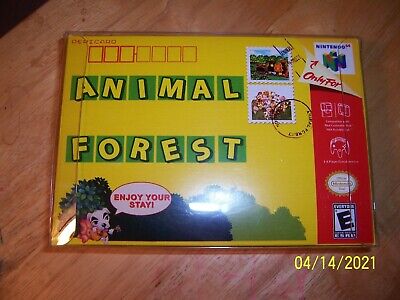3 min to read
Animal Forest (N64)
Embark on a Whimsical Journey: Animal Forest for N64
 The following is the community N64 English translation version of the game.
The following is the community N64 English translation version of the game.
About the game
In the annals of Nintendo 64 gaming history, “Animal Forest” stands out as a timeless and whimsical life simulation experience. Developed by Nintendo EAD and first released in Japan in 2001, this game introduces players to a charming virtual village inhabited by anthropomorphic animal residents. Serving as the precursor to the internationally renowned “Animal Crossing” series, “Animal Forest” lays the foundation for the beloved franchise with its endearing characters, engaging activities, and a real-time clock system that mirrors the passage of time within the game.
At its core, “Animal Forest” invites players to assume the role of a human character who arrives in a picturesque village populated by a diverse cast of animal neighbors. The village is a bustling ecosystem, each inhabitant possessing a distinct personality, interests, and quirks. As players interact with these lovable creatures, they forge friendships, undertake tasks, and contribute to the communal harmony that defines the heart of the game.
One of the standout features of “Animal Forest” is its real-time clock system, mirroring the passage of time in the game world. Seasons change dynamically, influencing the environment and the availability of different flora and fauna. This dynamic time system creates a sense of immersion and connection to the in-game world, encouraging players to adapt their activities based on the time of day, weather, and seasonal changes.
The gameplay mechanics are diverse and engaging, offering a plethora of activities to partake in. From fishing by the tranquil riverbanks to bug catching in the lush forests, players can immerse themselves in the simple joys of rural life. The village also hosts special events and festivals, adding a touch of festivity and camaraderie to the gameplay experience. Players can participate in these events, interact with the villagers, and even receive unique rewards for their involvement.
A notable aspect of “Animal Forest” is the open-ended nature of the gameplay. Unlike traditional linear narratives, the game unfolds at the player’s pace, allowing for personalization and creativity. The emphasis on player agency is evident in the ability to customize the character’s home, collect and display various items, and even visit other players’ villages using the Nintendo 64’s Transfer Pak accessory.
The game’s graphics, though limited by the hardware capabilities of the Nintendo 64, exude charm and warmth. The character designs are adorable, and the village environments are brimming with color and personality. The soundtrack, composed by Kazumi Totaka, complements the game’s relaxing atmosphere, featuring melodic tunes that have become synonymous with the “Animal Crossing” series.
“Animal Forest” also incorporates a unique connectivity feature with the Game Boy Color. By using the N64’s Controller Pak and linking it with a Game Boy Color, players can access an exclusive island known as the “Island of the Lost.” This additional content adds a layer of exploration and mystery, providing players with new challenges and opportunities for interaction with special island-dwelling characters.
In retrospect, “Animal Forest” serves as a testament to Nintendo’s ability to create endearing and enduring gaming experiences. Its influence is palpable in the subsequent iterations of the “Animal Crossing” series, which have garnered a massive global fanbase. The game’s combination of charming characters, open-ended gameplay, and the innovative use of real-time mechanics has left an indelible mark on the world of video games, making “Animal Forest” a cherished classic among Nintendo enthusiasts.